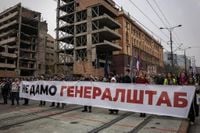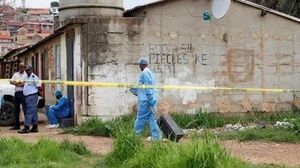On November 11, 2025, the streets of Belgrade, Serbia, pulsed with the energy of thousands of protesters forming a human shield around a bombed-out military complex—an act of defiance and remembrance. Their message was unambiguous: this historic site, partially destroyed during the 1999 NATO bombing campaign, should not be swept away in the name of luxury redevelopment by Affinity Global Development, a company linked to Jared Kushner, son-in-law of former U.S. President Donald Trump.
The demonstration, marked by a symbolic red line encircling the crumbling buildings, was the latest flashpoint in a year of persistent anti-government protests. Youth-led and fueled by a sense of cultural urgency, the crowd vowed to protect the complex from what they see as erasure of both history and identity. As one student told the Associated Press, “This is a warning that we will all defend these buildings together. We will be the human shield.”
The controversy centers on a $500 million plan to transform the site into a high-rise hotel, offices, and shops. This redevelopment, championed by the populist government of President Aleksandar Vucic, has faced fierce opposition from Serbian experts, the public, and international observers alike. Critics argue the military complex stands as an architectural monument and a symbol of resistance to the U.S.-led NATO bombing, which remains a deeply sensitive and unresolved chapter in Serbian collective memory.
Serbia’s government, however, paints a different picture. Officials claim the project will bring economic benefits and strengthen ties with the United States—a relationship currently strained by a 35% tariff imposed by the U.S. on Serbian imports and sanctions on the country’s Russian-controlled monopoly oil supplier, NIS. “The economic progress in Serbia over the past decade has been impressive,” Kushner stated when the deal was signed in May. “This development will further elevate Belgrade into the premier international destination it is becoming.”
Yet the process leading to this point has been fraught with controversy. Last year, the Serbian government stripped the complex of its protected heritage status and signed a 99-year lease agreement with Affinity Global Development, Kushner’s real estate investment company. The move raised eyebrows not only because of the site’s symbolic weight but also due to questions about the legality of the process. Serbia’s organized crime prosecutors have since launched an investigation into whether documents used to remove the protected status were forged, as reported by Reuters and the Associated Press.
The new law, passed by Serbian lawmakers on November 7, 2025, further accelerated the project by allowing faster administrative procedures for the redevelopment. The governing majority, despite claims from opposition politicians that the legislation was unconstitutional, approved it without amendments. The rationale, according to government supporters, is that the deal is crucial for good relations with the U.S., especially in light of ongoing economic and energy challenges.
But for many Serbs, the site is hallowed ground. The 1999 NATO bombing, which lasted 78 days, was intended to force then-President Slobodan Milosevic to end his crackdown on separatist ethnic Albanians in Kosovo. The campaign targeted bridges, military installations, and government buildings, resulting in the deaths of an estimated 528 civilians according to Human Rights Watch, and leaving a deep scar on the national psyche. Many see the bombed-out structures as a tribute to those who died and as prime examples of Yugoslav-era modernist architecture. As Reuters noted, opposition politicians and experts have repeatedly argued for the restoration of the complex’s protected status and for rebuilding, not demolition.
The redevelopment has also become entangled in broader political and social unrest. The protests that culminated in the human shield action are part of a yearlong wave of demonstrations that began after a tragic incident in Novi Sad on November 1, 2024, when a newly renovated train station canopy collapsed, killing 16 people. The incident fueled accusations of government corruption and mismanagement, with tens of thousands marking the tragedy’s anniversary earlier this month. The redevelopment of the military complex, seen by many as another example of questionable government dealings, has only intensified public anger.
Some protesters, like Teodora Smiljanic, voiced suspicions about the government’s motivations. “By passing this law he (Vucic) is aiming to please Trump and curry favour,” she told Reuters. “Perhaps he thinks that Trump in return could lift sanctions against NIS.” The fate of NIS, Serbia’s sole oil refinery and a key energy lifeline, is a point of anxiety as U.S. sanctions bite and winter approaches.
Political opposition figures have also weighed in forcefully. Zdravko Ponos, a former army chief of staff and now a leader of the opposition Srbija Centar party, told N1 TV, “He (Vucic) is trying to corrupt Trump.” The implication is that the project is less about economic development and more about political maneuvering on the international stage.
Affinity Global Development, for its part, has kept a low profile amid the uproar. Kushner, who established the company after leaving his White House role in 2021, has not responded to requests for comment on the protests or the ongoing investigation. The company has indicated plans to build a separate memorial for the 1999 bombing elsewhere, but this gesture has done little to mollify critics who view the redevelopment as an affront to Serbia’s historical memory.
The controversy in Belgrade is not occurring in isolation. Earlier this year, Kushner’s company secured approval for a $1.6 billion luxury resort on a communist-era fortified island in Albania, another Balkan nation. The parallel has not gone unnoticed by those wary of foreign investment reshaping the region’s historical landscapes.
As Serbia stands at this crossroads, the fate of the bombed-out military complex has become a potent symbol of larger debates: the balance between economic development and cultural preservation, the legacy of war and intervention, and the ways in which global politics ripple through local lives. The protesters’ human shield may not physically halt the bulldozers, but it has drawn a bright red line—both literally and figuratively—around the question of what Serbia chooses to remember, and what it is willing to let go.





